Common menu bar links
Institutional links
Diseases & Conditions
Health & Safety
Research & Statistics
Agency Information
Search Box
E-mail this page
Tuberculosis in Canada 2000
TUBERCULOSIS IN CANADA
2000
512 KB in PDF
Format Only ![]()
Cat.
H49-108/2000
ISBN 0-662-67074-4
Special Report of the
Canadian Tuberculosis Committee
TUBERCULOSIS AMONG THE FOREIGN-BORN IN CANADA
Background
Overview
From 1970 to 2000, the number of annual cases of tuberculosis (TB) among the foreign-born in Canada has not increased substantially. However, there has been a significant increase in the proportion of all cases of TB attributable to foreign-born individuals. The incidence of the disease is highest in the first few years of arrival, but cases continue to be diagnosed many years after arrival.
Methods
TB case data reported to the Canadian Tuberculosis Reporting System (CTBRS) from 1970– 2000 were examined. The reporting system is designed to capture information on every new active or relapsed case of TB occurring in Canada in all provinces and territories. Cases within the CTBRS meet the Canadian Tuberculosis Standards case definition1. The case report collects information on selected demographic characteristics, including origin. Origin for this report is defined as foreign-born (using World Health Organization Regions2), Aboriginal and Canadian-born non-Aboriginal. If a case report did not include information regarding origin it was excluded from analysis.
Results
Overall
The percentage of the total cases reported among the foreign-born has increased substantially since 1970. From 1970-2000 the proportion of TB cases among foreign-born persons in Canada increased from 18% of all cases reported to 65% (Figure 1). The incidence of disease and the total number of cases reported among the foreign-born has shown no appreciable increase (Figures 2 and 3). The number of cases in this population has increased by approximately 2% per year.
Figure 1
Proportion of TB cases in Canada by origin,
1970–2000
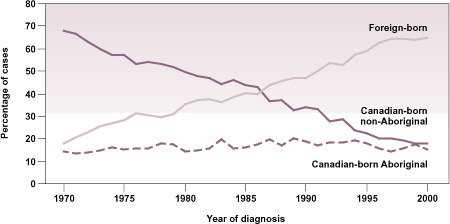
Figure 2
TB incidence in Canada, 1980–2000
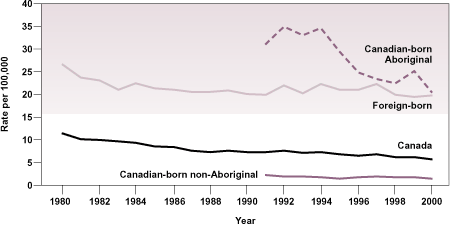
Overall, the incidence of disease is highest in this population within the first few years of arrival in Canada (Figure 4). In 2000, TB incidence in all foreign-born individuals was 19.5 per 100,000.
Figure 3
TB cases in Canada, 1970–2000
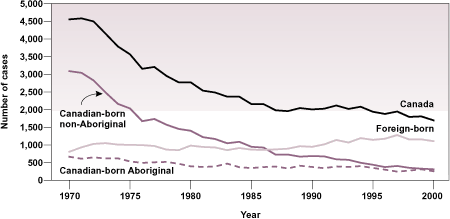
Figure 4
Incidence of TB among the foreign-born in Canada, 1st and 2nd year
after arrival
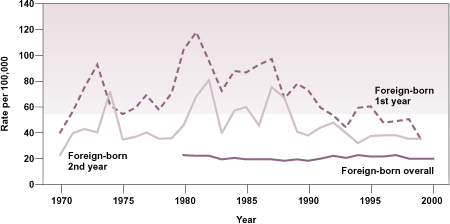
Of the foreign-born TB cases reported in 2000, 10% developed active TB within the first year of arrival, 17% within 2 years and 35% within 5 years. Although a significant proportion of TB in the foreign-born is diagnosed within the first 5 years of arrival, cases continue to be reported many years afterwards, dropping at a rate of approximately 10% a year (Figure 5).
The composition of TB cases among foreign-born persons reflects changing immigration patterns and trends. Over time, the majority of foreign-born cases were diagnosed in individuals from the Western Pacific Region. Cases of European origin have fallen off dramatically, whereas there is an increasing trend in the reporting of cases from South East Asia and Africa (Figure 6).
Figure 5
Foreign-born TB cases by year of arrival in Canada
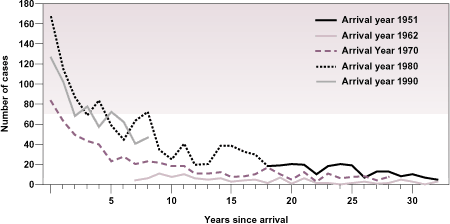
Figure 6
Foreign-born TB cases by WHO region
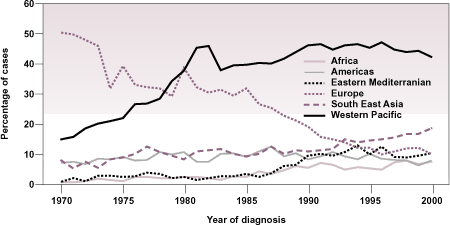
2000 Results
Geographic Distribution
The majority of foreign-born individuals (90%) settle in the provinces of British Columbia, Ontario and Quebec. Correspondingly, in 2000, these three provinces accounted for 87% of foreign-born cases (1,007 of 1,157 cases).
Demographic Characteristics
The median age of foreign-born TB cases was 39 years (landed immigrants 50 years, refugees 30 years and other non-residents 38 years) compared with the Canadian-born Aboriginal cases with a median age of 27 and Canadian-born non-Aboriginal cases at 59 years.
No significant difference was observed between the number of cases reported in males and females (51% and 49% respectively).
Clinical Characteristics
The rate of smear positive pulmonary TB in this population in 2000 was 6.1 per 100,000 and such cases accounted for 31% of all pulmonary TB reported in the foreign-born. No increased proportion of smear positive pulmonary cases was seen among the foreign-born population (50% of pulmonary cases) as compared with the Canadian-born population (55%).
The foreign-born account for a large percentage (66%) of the extrapulmonary TB reported in Canada. Of the extrapulmonary cases reported in the foreign-born, the majority were cases of TB diagnosed as peripheral lymph node disease. The foreign-born account for 80% of the peripheral lymph node disease reported in Canada, which is seen predominantly in individuals from the Western Pacific Region.
An increasing proportion of TB cases among Canadian-born and the foreign-born are being treated with three or more anti-TB drugs (foreign-born 1991 - 51%; 2000 - 68%; Canadian born 1991 - 54%; 2000 - 68%)
Of all cases of TB reported, 11% were resistant to one or more drugs, and 1% were multi-drug resistant (MDR-TB). The vast majority of drug resistant TB reported in Canada is in the foreign-born population. Of all drug resistant cases reported in Canada during 2000, 81% were in the foreign-born, as were 85% of MDR-TB. Overall, foreign-born cases are four times more likely to be drug resistant and six times more likely to be MDR than the Canadian-born.
Discussion
Why the shift?
A highly significant factor in the increased proportion of TB cases among foreign-born persons is changing trends in the countries of origin of migrants to Canada. More than 90% of all cases of TB in the world occur in developing countries. The World Health Organization (WHO) indicates that more than 85% of refugees originate from regions of the world with high TB rates2. Immigration has been increasing in Canada and specifically from countries where the incidence and prevalence of TB is high. Rates in these regions and in individual countries are up to 20 times higher than in Canada.
Furthermore, though screening for active TB disease of most immigrant and refugee populations is mandatory, a large percentage of disease develops after arrival in Canada. Most TB cases among foreign-born persons are likely the result of reactivation of remotely acquired infection3,4.
Risk to Canadians
In general, even though the proportion of TB in the foreign-born population has increased, significant transmission to persons born in Canada has not been commonly reported5. It has been hypothesized that the reasons for this lack of transmission are the mandatory screening for TB disease at the time of immigration, medical surveillance of those admitted with inactive TB, delayed integration of the migrant population and adequate treatment of cases.
Summary
Increasingly, reducing the burden of TB disease in Canada will depend on controlling the disease in foreign-born persons. The foreign-born have a greatly elevated risk of TB disease within the first 2 years of arrival, but the risk of developing TB remains for many years after arrival. Drug resistant TB is predominantly seen in this population but has not yet become a problem in Canada.
Directions
The elimination of TB in Canada will depend increasingly on the elimination of TB among the foreign-born. Although this presents challenges and requires a flexible approach, the priorities and guidelines put forward in the National TB Elimination Strategy6 remain the same:
-
Finding persons with active disease and ensuring completion of treatment;
-
Tracing the contacts of those with active disease and evaluating each contact's status regarding TB disease and infection;
-
Screening persons at high risk for infection, offering preventive therapy, and ensuring completion of preventive therapy.

Members of the Canadian Tuberculosis Committee: Dr. V. Hoeppner (Chair); Dr. M Baikie; Dr. C Balram; Ms. C. Case; Dr. E. Ellis (Executive Secretary); Dr. R.K. Elwood (Past Chair); Ms. P. Gaba; Dr. B. Graham; Dr. B. Gushulak; Ms. C. Helmsley; Dr. E.S. Hershfield; Ms. R. Hickey; Dr. A. Kabani; Dr. B. Kawa; Dr. R. Long; Dr. F. Stratton; Ms. N. Sutton; Dr. L. Sweet; Dr. T.N. Tannenbaum.
This report was prepared by Ms. Melissa Phypers, Senior Epidemiologist, Tuberculosis and Bacterial Respiratory Diseases, Health Canada. Special thanks to Ms. Dena Schanzer, Modeling and Projections Division, Health Canada, for assistance with the analyses required for this report.
Reference List
-
Canadian tuberculosis standards. Ottawa: Canadian Lung Association; Government of Canada, 2000.
-
World Health Organization. WHO report on the tuberculosis epidemic 2001. Geneva: Global TB Programme, 2001.
-
Small PM, Hopewell PC, Singh SP, Paz A, Parsonnet J, Ruston DC et al. The epidemiology of tuberculosis in San Francisco. A population-based study using conventional and molecular methods. N Engl J Med. 1994;330:1703-9.
-
Borgdorff MW, Behr MA, Nagelkerke NJ, Hopewell PC, Small PM. Transmission of tuberculosis in San Francisco and its association with immigration and ethnicity. Int J Tuberc Lung Dis 2000;4:287-94.
-
Menzies D, Chan CH, Vissandjee B. Impact of immigration on tuberculosis infection among Canadian-born schoolchildren and young adults in Montreal. Am J Respir Crit Care Med 1997;156:1915-21.
-
Health Canada. Proceeding of the national consensus conference on tuberculosis, December 3-5, 1997. CCDR 1998;24S2.
